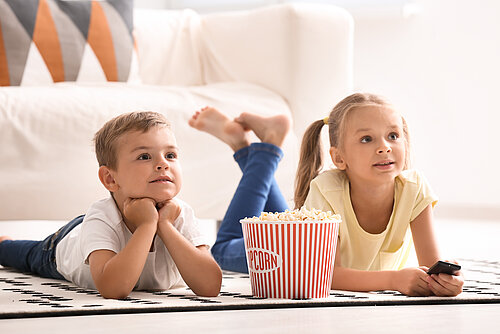
Why fear feels good
Why Do Tweens Love Scary Content, and How Does It Actually Help Them

With stranger things now only a month away, I am pretty confident it is going to be HUGE. I am also pretty confident that despite it’s 15 ratings, tweens will watch it in their boat loads.
As seen with Five nights and Freddys, Goosebumps, Dr Who, Horror games on Roblox, the allure of fear in late childhood is nearly universal. In a recent study of recreational “scary fun,” 93% of children were reported to enjoy at least one frightening-yet-fun activity (from ghost stories to thrill rides) and more than two-thirds sought out a scary thrill at least once a week. By the time kids approach adolescence, scary entertainment shifts from simple peek-a-boo games to media-based frights like horror movies and creepy video games. In fact, an early study found that while only about 40% of younger kids (7–8 years old) liked spooky programs, nearly 65% of preteens (11–12 years old) did.
What changes around the “tween” years that makes fear so enticing? Psychologists and child development experts suggest several intertwined reasons, from sensation-seeking biology to emotional mastery, identity, and even social bonding.
Chasing the Thrill – Safely
One big part of the puzzle is sensation-seeking – a personality trait describing people who love excitement and novelty. Children (and adults) who enjoy scary content often score high on sensation-seeking: they crave the adrenaline rush that comes with a jolt of fear. For tweens, spooky media can act like a roller coaster in book or movie form. When you’re scared, the brain pumps out a cocktail of stress and pleasure hormones that can make tweens intoxicated with excitement. Just standing at the exit to a “house of horrors” waiting for my 10 year old and his friends to exit showed me the almost narcotic effect of being scared witless by a man dressed as Freddy Cruger. In other words, being safely scared feels good. As R.L. Stine – famed author of the Goosebumps series – puts it, “I think everyone likes a good scare… to face monsters when they know they’re safe at the same time.” When kids read his books, “they’re facing a lot of their real fears… but know that they’re not in any real danger,” Stine explains. This “safe fear” is key: the child gets all the fun of a scare without actual harm.
Psychologists even have a term for deliberately seeking scary-but-fun experiences: recreational fear. Unlike genuine terror, recreational fear is a playful kind of fright – the goosebumps and gasps we choose to experience for entertainment. Throughout childhood, recreational fear is common and, many argue, healthy. It provides a low-stakes training ground for emotions.
Mastering Monsters and Emotions
Beyond the biochemical thrill, scary stories serve a deeper purpose: they help kids practice dealing with fear and build emotional resilience. If negotiating who gets to have the truck in the sandpit next is practice for real world social interactions, watching scary stories is a great practice ground for dealing with fear.
In scary stories chidlren can confront monsters, whether a literal “monster under the bed” or a metaphorical one, and learn that fear can be endured and managed. Psychologists connect this to the concept of mastery: by controlling a dose of fear, kids gain a sense of power over it. In fact, when children identify with a brave protagonist who overcomes something terrifying, they feel empowered by proxy. As one analysis describes, “As the child identifies with the protagonist, who overcomes terrifying difficulties, they build a sense of empowerment and resilience.” The hero’s victory is their victory.
Consider popular tween fright-fests like Stranger Things or Coraline. In Stranger Things, a band of middle-school friends face down interdimensional monsters – and viewers around the same age eat it up, not just for the ʼ80s nostalgia and creepy creatures, but because they see kids like them triumph over evil. In Coraline, a young girl navigates a nightmarish parallel world ruled by the Other Mother (button eyes and all) and ultimately wins.
Such stories are scary, but they are also deeply satisfying narratives of courage. They reassure kids that even if evil is scary, it can be defeated. Facing fear and then overcoming it is the whole point.
Modern psychological research supports the idea that manageable scary play is beneficial. One recent study suggests that voluntarily engaging with mild fear helps children learn their own limits and practice regulating their emotions. The authors liken it to “risky play” – the way children play at heights or speed to train their risk management. By experimenting with fear in controlled, enjoyable doses, kids may be building coping skills and resilience that serve them later in life. Indeed, many classic fairy tales and cautionary folk stories served exactly this function: to warn children of dangers (the wolf in the woods, the witch in the candy house) in a scary narrative form, effectively immunising them with a little fear to prepare for real-world challenges.
Growing Up Brave (and Morbidly Curious)
For 9–13 year-olds, seeking out scary content can also be a way of exploring identity and maturity. Tweens exist in a kind of in-between stage (hence the name) no longer little kids, not yet full teenagers. Naturally, many are eager to prove they’re not afraid of the dark (at least, not as much as “little kids”). Watching a horror movie or reading an edgy scary book can feel like a rite of passage or a badge of courage. They might brag about having made it through Goosebumps’ scariest tale or about playing Five Nights at Freddy’s with the lights off. “Kids like to be scared,” R.L. Stine has observed – it’s what they want, which is why he’s “been scary ever since” he discovered that secret. Part of that desire may come from morbid curiosity, our tendency to be intrigued by the dangerous or taboo. Tweens hear playground whispers about the latest creepy YouTube video or a gruesome urban legend, and though it’s scary, they have to know more. This curiosity – peeking through fingers at the horror on screen – is a natural way for kids to grapple intellectually with the concept of danger and the macarbre.
Biologically, early adolescence also brings changes that can heighten thrill-seeking. The reward centers of the brain become more sensitive around puberty, which can make intense experiences more appealing. The American Academy of Pediatrics notes that boys in particular tend to watch and enjoy scary, violent content more than girls (though plenty of girls love horror too). Some researchers theorise this is partly social conditioning, boys may feel pressure to appear fearless and sensation-seeking is a good outlet for this.
Regardless, by ages 11–13 many kids start testing boundaries through media. They push into scarier territory as a way to assert independence (“I can handle it!”) and to experience a touch of adult-level fear while still under the security blanket of childhood.
Sharing the Scare: Social Bonds in the Dark
Interestingly, the thrill of scary entertainment isn’t just a solo experience – it’s often deeply social. Think of telling ghost stories around a campfire, or a group of tweens huddled together during a creepy movie night. A recent cross-sectional study of kids’ found that “scary fun” is predominantly a social experience: younger children often engaged in scary play with parents or siblings, while older kids turned to friends as their primary scary-movie buddies.
By age 11 or 12, many are watching horror at sleepovers or trading spooky TikToks with their peers, often beyond the watch of parents. Sharing an intense or frightening experience can strengthen social bonds. There’s a camaraderie in clutching each other’s arms during a jump-scare, or excitedly dissecting the craziest scenes after the credits roll. Fear, it turns out, can be glue for friendships. As one commentary observed, when kids consume the same frightening story, “they frequently bond via their mutual terror and enthusiasm.” The shared experience of being scared together often creates “long-lasting bonds and memories” among friends. Even the playground chatter about a scary trend (say, the eerie challenges of “Hello Neighbor” or the mysterious Mind Flayer in Stranger Things) gives kids a common lore to connect over.
Peer influence also plays a role: if “everyone” is talking about the new horror movie or viral scary game, curiosity spreads. A trendy fright like Squid Game or The Backrooms can become forbidden fruit – making it even more enticing to tweens, who don’t want to feel left out. In moderation, this social sharing of scares can be positive. Watching or reading together provides a sense of safety (“we’re all in this together”), and kids often take cues from each other on how to react. Psychologists note that having others present can actually help a child manage their emotional response, making the fright more fun than traumatising. Laughter often follows screams in a group, as they collectively turn fear into something to giggle about. In this way, scary media becomes a team sport – one that forges friendships and even familial closeness (for instance, when parents and kids bond over spooky Halloween movie traditions).
Fear as Fun – and Growth
Ultimately, the paradox of kids seeking out scares isn’t so puzzling. For tweens, scary entertainment hits a sweet spot: it’s a thrill ride, a testing ground, and a social glue all at once.
A well-crafted fright makes their hearts race and their confidence bloom. It’s fun and formative. As one expert put it, childhood itself can be frightening, kids live in a world full of uncertainties and things much bigger than them. Spooky stories and games give them a chance to toy with fear on their own terms, perhaps making the real world feel a little less intimidating. They can “[dance] with their fears in a safe way,” learning “how to survive monsters and be powerful too” in the process. After braving the dark imaginings of a story, the everyday challenges – a tough exam, a new school, a dark room at night – might seem just a bit more conquerable.
None of this is to say every child should binge horror movies with abandon. Parents still need to gauge what level of scary content is appropriate; every kid’s sensitivity is different. A fun fright for one might be nightmare-fuel for another. But in general, research and experience suggest that age-appropriate scary entertainment offers more than just cheap thrills. It can be a tool for growth – helping kids practice managing fear, build empathy and confidence, and bond with others.
The next time you catch a middle-schooler wide-eyed at a ghost story or glued to a spooky Netflix series, remember: beyond the goosebumps lies a lot of developmental goodness. As one author reminds us “there’s no triumph without a little terror”. And for kids on the cusp of adolescence, triumphing over their imagined monsters can be fantastic practice for facing the real ones.


